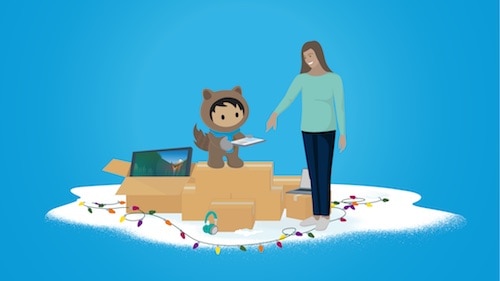This is the second post of a two-part series sharing the perspective of Salesforce Consulting Partners on everything retailers need to do for a successful 2019 holiday season.
We surveyed our Salesforce Consulting Partners to better understand the top ways that retailers can differentiate from competitors this holiday season and, unsurprisingly, personalization was the clear winner — and it pays off. Personalized experiences yield a 4.5x higher cart rate and 5x higher per-visit spend, not to mention a better overall experience and higher loyalty.
Take it from two of them:
“Personalization will be one of the key ways for brands to effectively drive new customers and improve loyalty to the brand. AI will be helpful to identify trends to help brands adjust strategies quickly.” — Todd Bowman, Merkle Inc.
“There is a significantly small window of opportunity to capture holiday sales between Black Friday and the holidays. Oftentimes, companies try to get ahead of any problems with fulfillment and shipping cutoff time. We suggest that companies take advantage of their retail locations and office spaces for fulfillment. Companies must understand their localized landscapes and leverage them to optimize supply chains for holiday delivery.” — Libby Morgan, Optaros by MRM//McCann
Personalization comes in many forms and is embedded throughout the shopping experience. With the insight and expertise of our Partners, we’ve highlighted three ways to embed personalization into your holiday program.
1. Personalize content and promotions
“AI will be a game-changer. AI is not the ‘end all be all,’ but it will help marketers target customers differently. If a customer is more likely to purchase a specific item and is targeted differently, that will create significant opportunities for increased revenue during the holiday season.” — Craig Robinson, Merkle Inc.
“One-to-one marketing concepts have been around since the ‘90s but have so far failed to achieve the utopian claims. That said, by combining technologies rather than looking at these in isolation, we will start to see some break-throughs whereby AI (in all its forms) starts to drive personalisation in the form of next-purchase prediction against a demand moment.” — Austin Wildmore, VP Consumer Products Industry, PolSource
Getting emails right this holiday season is crucial. For every $1 spent on email, retail and consumer goods brands see a $45 return. Content and promotions should be tailored to what you know about your customers — from age to sex to shopper history and more. This means that the content displayed for a first-time shopper versus a shopper with loyalty status should be significantly different.
You can do this by using data, data, and more data. Take the time to understand your shopper from their behavior and preferences to what time they open emails. All of these trends will inform how you approach dynamically serving up future personalized content and offers.
“A lot of brands will be incredibly promotion-focused. Rather than just promoting up to 60% off to try to keep up with competitors, brands can be more targeted with their offers and use data to determine the best offer for a person. If they’ve purchased in the past, they may not need as much incentive. If they’ve already purchased during the season, they may not be planning to purchase again so a higher offer may help push them to make a purchase again. Using data to inform promotional offers and thresholds will allow brands to differentiate themselves by protecting margins more.” — Jennifer Horner, DEG, Linked by Isobar
“Organisations must use data to proactively inspire customers at the right time and the holiday season is a perfect example. Brands now have enough data to understand what customers regularly buy, and whether or not that is for personal reasons or as a gift. Proactive inspiration will mean that companies, organisations, and brands can target customers rather than waiting for them. It’s personalisation, but not as we know it.” — James Webster, Head of Managed Services and Peak Trading Expert at Wunderman Thompson Commerce
Next, map out your communications for each of your shopper personas, especially those who abandon your site while searching, browsing, or adding items to their carts. Pre-built templates are key here; create and implement common assets like cart-abandon retargeting ads, emails personalized with products shoppers viewed or left in their carts, or SMS reminders to complete a purchase.
“Contextual and in the moment promotions — knowing when and what to send a customer wherever they are to drive an action.” — Kevin Hogan, Deloitte
Being that it’s the holiday season, don’t forget to include holiday design elements and emphasize special shipping dates and select product categories.
2. Personalize product recommendations
In addition to personalized content and promotions, leverage product recommendations that learn about your shoppers’ preferences and get smarter with every click to help you tailor the shopping experience and drive sales. According to our Holiday Readiness Guide, product recommendations makeup 26% of revenue and increase average order value (AOV) by 10%. Last year’s holiday season actually saw a 14% increase. Shoppers are also nearly twice as likely to come back to a site that serves up personalized recommendations.
“Customers are expecting more personalized offers from brands in exchange for providing their personal information. Brands need to use this to their advantage. Personalizing offers based on recent behavior, past holiday season behavior, and current behavior, such as online browsing information, to personalize communications is key. Connecting outbound communications, such as email and SMS, to the website experience can help create a more seamless experience for the customer.” — Jennifer Horner, DEG, Linked by Isobar
Product recommendations come in multiple formats — the most common is predictive product recommendations, which deliver highly personalized product suggestions. You can also tailor the shopping experience by gaining deeper insights into products that are typically purchased together, such as running shoes and an exercise tracker, to create product bundles that are popular with shoppers, customize the order in which products appear based on shopper behavior so they see products they’re more likely to click on and buy, and automatically surface terms not already on your keyword list with synonyms, hypernyms, and search redirects (think “sandals,” “flip-flops,” or “slides,” and “blue,” “navy,” or “aquamarine”).
“Next-best actions and product recommendations based on previous purchases or browsing history will help traditional retailers compete with Amazon and online retailers that have built their business with these features.” — Steve Buzinski, Business Development Manager, Retail, Traction on Demand
Incorporating AI this holiday season will give you deeper insights into your customers and remove labor-intensive merchandising activities.
3. Personalize service
And no shopping experience is complete without a great service experience. During Cyber Week 2018, we saw a move in cases across channels as more shoppers took inquiries to social, messaging, and chat. Be ready for the influx in cases by using AI to power faster, smarter customer service to resolve cases and increase satisfaction.
“Problems are going to happen. Things will ship late, stock will run out, sizes will always be an issue. Customer Service and the ability to quickly remedy a shopper’s concerns will reduce negative NPS, online communication and reviews and ultimately contribute to more brand advocates.” — Steve Buzinski, Business Development Manager, Retail, Traction on Demand
Chatbots are a great place to start. Bots scale support and provide personalized service while giving your service agents more time to spend building meaningful relationships with shoppers. A chatbot in retail should answer simple questions like “What is my order status?”, “How do I initiate a return?”, and “What’s my username to reset my password?” If bots can’t answer a question, they can escalate the case to a live agent and collect and qualify shopper information to reduce the total handle time. Salesforce Einstein Bots get smarter over time and can provide consultative selling.
“There is a new battleground for consumer loyalty. Satisfaction is not a predictor of loyalty. And although some may think a strategy of delight will pay off with more loyalty, consumers are desiring a more “human-like” experience with the brands they engage with. This means gaining consumer satisfaction through a more human-like conversation and knowing when to wow them and when to simply help them get their issue resolved in as fast a manner as possible. Consumers don’t want to be treated like flock and many of today’s customer experience campaigns and strategies only address this at a macro level, leaving large opportunities for retailers especially to begin changing how they communicate with consumers.” — Kevin Hogan, Deloitte
You can also use AI to transform your contact center. For example, you can analyze incoming cases and move priority ones to the front of the queue while preparing agents with all available details before they start their interaction. This includes communication prompts and recommended actions so they’re prepared when cases come in. You can also further drive sales by empowering service agents with relevant product groupings and recommendations based on purchase history so service agents are prepared to upsell.
The holiday season is the most wonderful time of the year to meet shoppers where they are — and tap into who they are. From marketing to commerce to service, personalization is poised to improve brand loyalty, drive new customers, and create meaningful experiences.
For more tips and best practices, check out our Connected Shoppers Report, Holiday Shopping Insights and Predictions, and part one of this series.




























